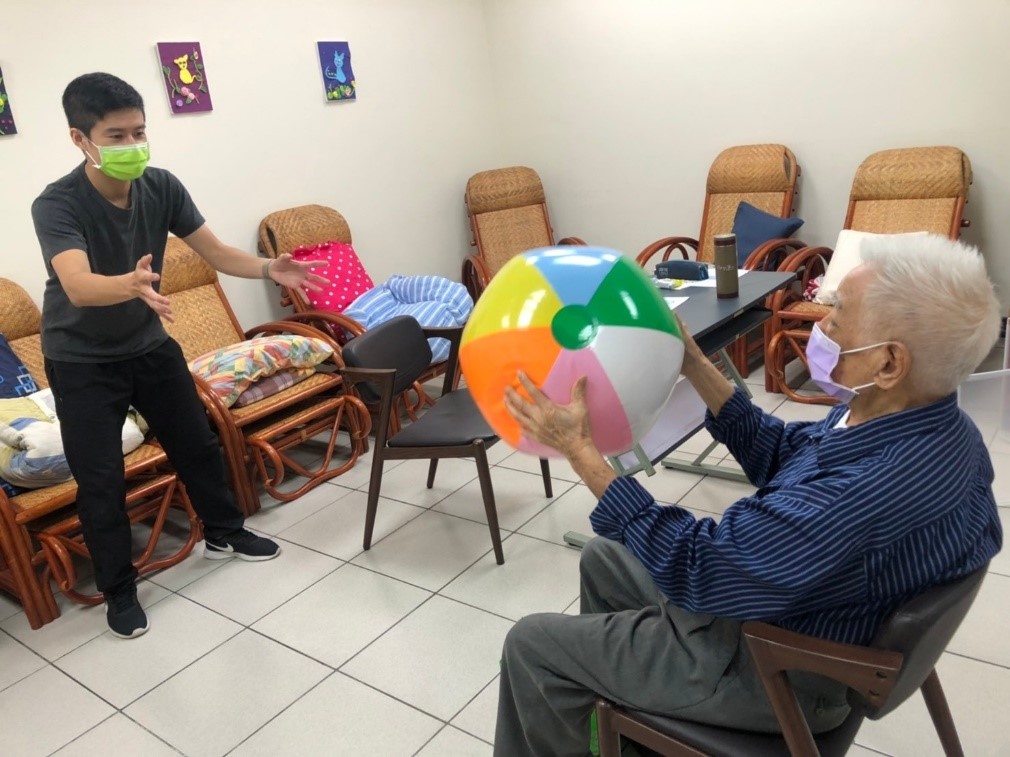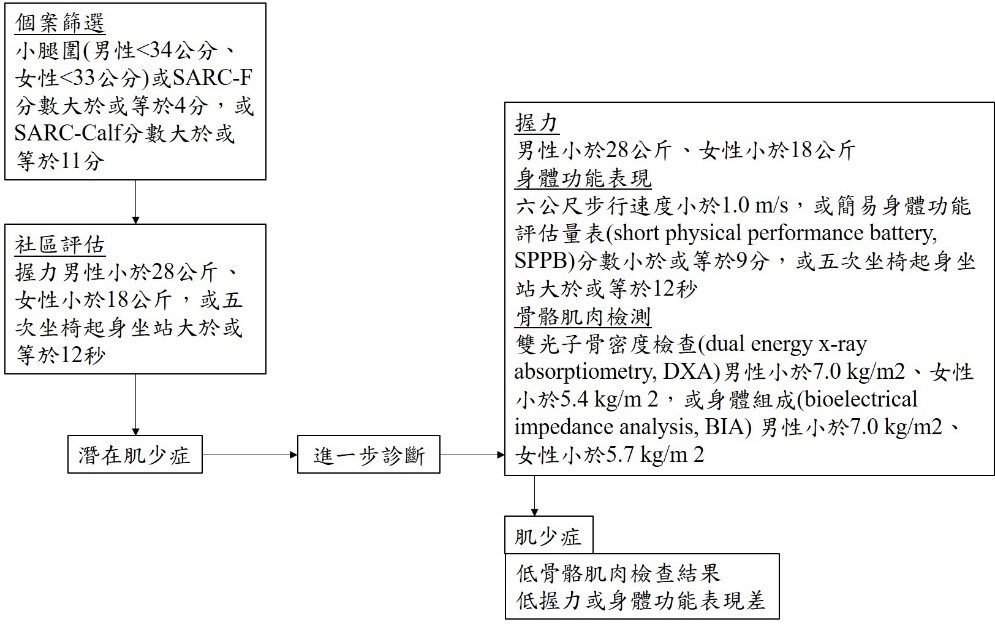以提升高齡肌少症者「身體活動量」為主的復能介入方案介紹
高齡暨長期照護研究中心游曉微

肌少症(sarcopenia)被視為老化所伴隨的生理衰退現象,與不良預後、失能風險、死亡風險皆有相關 (Cesari et al., 2016)。亞洲國家報導指出,韓國社區高齡者男性為13.1 – 14.9%、女性為11.4% (Choo & Chang, 2021);日本社區高齡者男性為11.5%、女性為16.7% (Kitamura et al., 2021);中國社區高齡者男性為12.9%、女性為11.2%,入住護理之家男性高齡者肌少症盛行率26.3%、女性盛行率33.7% (Chen et al., 2021)。臺灣學者依據2019年亞洲肌少症工作小組規範標準,研究日間照顧中心六十五歲以上高齡者肌少症的盛行率發現,50.9%高齡者為確認肌少症、47.4%高齡者為潛在肌少症(possible sarcopenia) (Chang et al., 2021)。以上數據見得,高齡者肌少症盛行率性別差異不一致,但「需要長照服務族群人口」肌少症盛行率,明顯高於一般社區高齡者。

實證為基礎的研究指出,有效的介入方案能幫助改善及延緩高齡者肌少症。有效的介入策略,指的是強調肌力與肌耐力等訓練 (Serra-Prat et al., 2017);世界衛生組織更倡議高齡者維持足夠且規律的「身體活動(physical activity)」,學者亦將提升高齡者身體活動量介入模式,列為預防及延緩肌少症或衰弱(frailty)的解方 (Marzetti et al., 2017)。近期,國際高齡政策近期開始注重健康老化、失能預防,以及自主管理,從傳統以協助性導向(doing for)文化,逐漸轉變成為陪同(doing with)照顧,也就是「復能(reablement)」照顧概念 (International Federation on Ageing, 2016)。我國長照2.0亦導入復能服務,透過功能訓練、環境及輔具支持等策略,支持協助高齡者習得自我照顧能力,進而減輕照顧者負擔 (中華民國衛生福利部, 2019)。復能,除了強調一般的日常生活功能、工具性日常生活功能、自我照顧技巧學習之外,也有一派主流學者認為增加高齡者「身體功能活動量」是有效的介入策略 (Resnick & Galik, 2013),並且發表多篇結合身體活動提升之復能介入於有效改善高齡者健康的實證研究 (Resnick et al., 2021; Resnick et al., 2022; Resnick et al., 2020)。據此,透過結構性的復能設計及導入,將身體活動融入常規訓練,預期能減少高齡者肌少症的嚴重度。
著重於高齡者「身體活動量提升」的復能介入,也就是說,透過結構性的復能設計及導入,將身體活動融入常規化的生活中(例如:針對長照需要個案的走路計畫、社區高齡長輩的健走計畫),將能幫助延緩或回復高齡者肌少症風險。常規性身體活動介入的實證研究方面:日本骨鬆與預防失能的千人研究發現,中高齡者保有身體活動或運動習慣,是維持肌力和較佳身體功能表現的保護因子,進而與肌少症風險有關 (Akune et al., 2014);在美國大型的多點且隨機控制試驗(高齡者生活型態介入與自主性Lifestyle Interventions and Independence for Elders)長期研究的結果建議,應將走路(只少每週150分鐘)、個人化的肌力、伸展與平衡活動(視個案狀況來擬訂身體活動目標)納入常規身體活動指導方案 (Pahor et al., 2014)。後設系統分析(meta-analysis)結果顯示,常規性的身體活動是肌少症的保護因子 (Steffl et al., 2017);實證研究也認為,增加高齡者身體活動量,可以改善步行速度及平衡能力、提升日常生活功能能力 (Chou et al., 2012)。老化臨床介入期刊的回顧建議也提到,透過維持身體功能和移動能力(mobility)像是走路,是對於高齡肌少症的最佳解方 (Billot et al., 2020)。
提升高齡肌少症者「身體活動量」為主的復能介入方案,是透過治療師團隊(物理及職能治療師為主)的功能性評估、設計訓練方案、與照顧服務員共同指導訓練活動、追蹤成效等方式,針對日間照顧中心的肌少症高齡者,實施一系列「個人化復能訓練」及「基礎團體活動」。「個人化復能」為連續10~12次介入,由治療師為個案制定個人化復能目標,並指導照顧者(含家庭照顧者或主要照顧服務員)復能技巧與提升個案身體活動量策略,通常以行走的日常生活功能性訓練、轉移位到廁所如廁練習為主,甚至也有誘發失智者動機以從事復能訓練的活動;「基礎團體活動」則是由治療師設計之團體活動,針對核心肌群的肌力、肌耐力、平衡等多元體適能,並且在個案執行團體活動時,從旁觀察監督個案的個人需要強化元素(例如右側偏癱者,右手頭舉動作時需要部份協助)。兩項介入活動,皆以「提升身體活動量」為出發點,並且強調治療師與照顧服務員/或家庭照顧者共同協助指導高齡者。
整體來說,復能介入融入「身體活動」訓練,在本方案初步研究結果顯示:六公尺步行速度、日常生活功能獨立性等兩項指標有顯著進步,呼應過去文獻研究證據顯示「提升身體活動量是肌少症的保護因子」 (Billot et al., 2020)。然而,本方案初步導入日間照顧中心個案,期望未來有更大規模介入方案實證數據,以提供產、官、學界設計預防及延緩肌少症之方案內容參考。
參考文獻
Akune, T., Muraki, S., Oka, H., Tanaka, S., Kawaguchi, H., Nakamura, K., & Yoshimura, N. (2014). Exercise habits during middle age are associated with lower prevalence of sarcopenia: the ROAD study. Osteoporos Int, 25(3), 1081-1088. https://doi.org/10.1007/s00198-013-2550-z
Billot, M., Calvani, R., Urtamo, A., Sánchez-Sánchez, J. L., Ciccolari-Micaldi, C., Chang, M., Roller-Wirnsberger, R., Wirnsberger, G., Sinclair, A., Vaquero-Pinto, N., Jyväkorpi, S., Öhman, H., Strandberg, T., Schols, J., Schols, A., Smeets, N., Topinkova, E., Michalkova, H., Bonfigli, A. R., . . . Freiberger, E. (2020). Preserving Mobility in Older Adults with Physical Frailty and Sarcopenia: Opportunities, Challenges, and Recommendations for Physical Activity Interventions. Clin Interv Aging, 15, 1675-1690. https://doi.org/10.2147/cia.S253535
Cesari, M., Prince, M., Thiyagarajan, J. A., De Carvalho, I. A., Bernabei, R., Chan, P., Gutierrez-Robledo, L. M., Michel, J. P., Morley, J. E., Ong, P., Rodriguez Manas, L., Sinclair, A., Won, C. W., Beard, J., & Vellas, B. (2016). Frailty: An Emerging Public Health Priority. J Am Med Dir Assoc, 17(3), 188-192. https://doi.org/10.1016/j.jamda.2015.12.016
Chang, C. F., Yeh, Y. L., Chang, H. Y., Tsai, S. H., & Wang, J. Y. (2021). Prevalence and Risk Factors of Sarcopenia among Older Adults Aged ≥65 Years Admitted to Daycare Centers of Taiwan: Using AWGS 2019 Guidelines. Int J Environ Res Public Health, 18(16). https://doi.org/10.3390/ijerph18168299
Chen, Z., Li, W. Y., Ho, M., & Chau, P. H. (2021). The Prevalence of Sarcopenia in Chinese Older Adults: Meta-Analysis and Meta-Regression. Nutrients, 13(5). https://doi.org/10.3390/nu13051441
Choo, Y. J., & Chang, M. C. (2021). Prevalence of Sarcopenia Among the Elderly in Korea: A Meta-Analysis. J Prev Med Public Health, 54(2), 96-102. https://doi.org/10.3961/jpmph.21.046
Chou, C. H., Hwang, C. L., & Wu, Y. T. (2012). Effect of exercise on physical function, daily living activities, and quality of life in the frail older adults: a meta-analysis. Arch Phys Med Rehabil, 93(2), 237-244. https://doi.org/10.1016/j.apmr.2011.08.042
International Federation on Ageing. (2016). Copenhagen Submit Report on Reablement and Older People. https://www.ifa-fiv.org/publication/health/copenhagen-summit-report-reablement-older-people/
Kitamura, A., Seino, S., Abe, T., Nofuji, Y., Yokoyama, Y., Amano, H., Nishi, M., Taniguchi, Y., Narita, M., Fujiwara, Y., & Shinkai, S. (2021). Sarcopenia: prevalence, associated factors, and the risk of mortality and disability in Japanese older adults. J Cachexia Sarcopenia Muscle, 12(1), 30-38. https://doi.org/10.1002/jcsm.12651
Marzetti, E., Calvani, R., Tosato, M., Cesari, M., Di Bari, M., Cherubini, A., Broccatelli, M., Savera, G., D’Elia, M., Pahor, M., Bernabei, R., & Landi, F. (2017). Physical activity and exercise as countermeasures to physical frailty and sarcopenia. Aging Clin Exp Res, 29(1), 35-42. https://doi.org/10.1007/s40520-016-0705-4
Pahor, M., Guralnik, J. M., Ambrosius, W. T., Blair, S., Bonds, D. E., Church, T. S., Espeland, M. A., Fielding, R. A., Gill, T. M., Groessl, E. J., King, A. C., Kritchevsky, S. B., Manini, T. M., McDermott, M. M., Miller, M. E., Newman, A. B., Rejeski, W. J., Sink, K. M., & Williamson, J. D. (2014). Effect of structured physical activity on prevention of major mobility disability in older adults: the LIFE study randomized clinical trial. JAMA, 311(23), 2387-2396. https://doi.org/10.1001/jama.2014.5616
Resnick, B., Boltz, M., & Galik, E. (2021). Reliability and Validity of the Function-Focused Care Checklist for Caregivers. Rehabil Nurs, 46(3), 155-162. https://doi.org/10.1097/rnj.0000000000000294
Resnick, B., Boltz, M., Galik, E., Fix, S., Holmes, S., & Zhu, S. (2022). Model Testing of the Factors That Influence Performance of Function Focused Care and Function Among Assisted Living Residents. J Appl Gerontol, 41(2), 401-410. https://doi.org/10.1177/0733464820976435
Resnick, B., & Galik, E. (2013). Using function-focused care to increase physical activity among older adults. Annu Rev Nurs Res, 31, 175-208. https://doi.org/10.1891/0739-6686.31.175
Resnick, B., Galik, E., Boltz, M., Holmes, S., Fix, S., Lewis, R., & Vigne, E. (2020). Reliability and Validity of the Checklist for Function-Focused Care in Service Plans. Clin Nurs Res, 29(1), 21-30. https://doi.org/10.1177/1054773818783178
Serra-Prat, M., Sist, X., Domenich, R., Jurado, L., Saiz, A., Roces, A., Palomera, E., Tarradelles, M., & Papiol, M. (2017). Effectiveness of an intervention to prevent frailty in pre-frail community-dwelling older people consulting in primary care: a randomised controlled trial. Age Ageing. https://doi.org/10.1093/ageing/afw242
Steffl, M., Bohannon, R. W., Sontakova, L., Tufano, J. J., Shiells, K., & Holmerova, I. (2017). Relationship between sarcopenia and physical activity in older people: a systematic review and meta-analysis. Clin Interv Aging, 12, 835-845. https://doi.org/10.2147/cia.S132940
中華民國衛生福利部. (2019). 長照復能服務操作指引. Retrieved May 08 from https://1966.gov.tw/LTC/cp-4444-47438-201.html